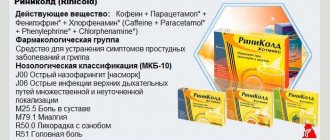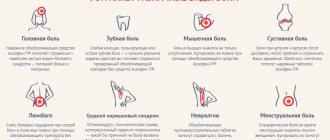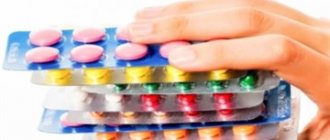Pharmacodynamics and pharmacokinetics
This drug is an analgesic and sedative. Its action is determined by the substances included in its composition.
Metamizole sodium has an analgesic and moderate anti-inflammatory effect, which is achieved by inhibiting cyclooxygenases type 1 and 2.
Tempidone helps eliminate anxiety, get rid of fear, reduce motor agitation and slightly reduce blood pressure . These substances are capable of potentiating each other's effects.
The drug is characterized by rapid absorption from the gastrointestinal tract. Its effect manifests itself after 30 minutes, and the maximum concentration in the blood is detected after 1-2 hours. The substance is metabilized in the liver. The drug is excreted from the body in the form of metabolites and partly in unchanged form along with bile and urine.
Composition, form and action
"Tempalgin" includes:
- Metamizole sodium.
- Triacetomine-4-toluenesulfonate.
- Excipients: wheat starch;
- povidone;
- macrogol;
- talc;
- dye, etc.
The drug tablet consists of 500 mg of metamizole and 20 milligrams of triacetomine, coated. The medicine belongs to the group of non-narcotic analgesics, the essence of which is to relieve pain and reduce fever, without affecting inflammatory processes. The duration of action of the drug is extended due to the mutual influence of metamizole and triacetomine. The advantage of Tempalgin is its long-lasting action (6-8 hours) combined with good absorption in the body and easy excretion without accumulation. The tablets are packaged in blisters, each of which contains 10 pieces. The pack consists of 2, 10 or 30 blisters.
Indications for use of Tempalgin
Main indications for use of Tempalgin:
- various pain syndromes - neuralgia, headache and toothache, migraines, myalgia;
- visceral pain manifestations, for example, renal, intestinal, and hepatic colic;
- reduction of mild pain syndromes after examinations and operations.
Description of the medicine
So, what is “Tempalgin” for? The medication has a complex effect on the human body.
It has the following properties:
- analgesic;
- antipyretic;
- sedative.
Most people know what Tempalgin helps with and, if necessary, resort to this medication. The product quite effectively eliminates pain syndromes provoked by a variety of factors. This medicine is often used for severe migraines. This medication is used for toothache and many other pathologies that cause unpleasant discomfort in a person.
The medicine is an antipyretic. Therefore, you should know what Tempalgin can get rid of. The medication is used for febrile conditions and high temperatures. Often this remedy is included in complex therapy for acute respiratory viral infections and influenza.
In addition, the medicine can have a calming effect on the nervous system. The drug can eliminate such negative manifestations as fear, motor agitation, and anxiety. Taking the medicine helps lower blood pressure.
The product has a quick effect on the body. After taking the medication, the sedative effect will appear within half an hour. Analgesic effects can be expected within 1-2 hours.
The medicine is produced in only one dosage form - in the form of tablets.
Tempalgin contraindications
Main contraindications for use:
- arterial hypotension;
- deficiency of glucose-6-phosphate dehydrogenase;
- severe forms of liver and kidney failure;
- hematopoietic disorder;
- pregnancy, lactation;
- aspirin asthma;
- hypersensitivity;
- childhood.
Why can't you use
The drug is prohibited for use in the following body conditions:
- Severe kidney failure
- Low blood pressure
- Severe liver failure
- Asthma due to allergy to aspirin
- Chronic heart failure
- Problems with hematopoiesis
- Individual intolerance
Side effects
When taking Tempalgin M tablets, side effects may develop: headaches, dizziness, hallucinations, jaundice, cholestasis, hyperfermentemia, hyperbilirubinemia, epigastric pain, vomiting, nausea, pressure disturbances, tachycardia, cyanosis, leukopenia, thrombocytopenia, and granulocytosis, proteinuria, oliguria and etc.
In addition, the development of allergic effects in the form of urticaria, Quincke's edema, skin itching, exudative erythema, bronchospasm, and anaphylactic shock is possible.
Why are there allergies?
Any drug always has undesirable effects. Specifically, Tempalgin does not often have side effects on the body. Usually, this occurs only against the background of long-term use of the drug. They manifest themselves in organ systems as follows:
- Burning sensation in the epigastrium, increased levels of ALT and AST, jaundice, increased bilirubin, cholestasis.
- Increased symptoms from the central nervous system, up to the occurrence of hallucinations.
- Changes in blood pressure, increased heart rate, and the appearance of cyanosis.
- Renal dysfunction
- Allergy in its various manifestations.
Tempalgin tablets, instructions for use (Method and dosage)
Instructions for use Tempalgin recommends taking the tablets orally, after eating, with plenty of water. The dosage of the drug depends on the severity of pain and the individual characteristics of the patient.
Adults are usually prescribed one piece per day, taken 1-3 times a day. In this case, the maximum single dosage cannot be more than 1 tablet, daily - up to 4 pieces. During dental procedures, you need to take one tablet half an hour before the intervention.
The annotation for the drug also states that children over 15 years of age can take no more than 2 tablets per day.
The duration of therapy should not exceed 3-5 days. Beyond this period, the drug should be taken only as prescribed by a doctor.
Tempalgin tab.pp.o.No. 100 57207
Latin name
Tempalgin®
Active substance
Metamizole sodium + Triacetonamino-4-toluensulfonate*(Metamizolum natrium + Triacetonamino-4-toluensulfonas)
ATX:
N02BB72 Metamizole sodium in combination with psycholeptics
Pharmacological group
Combined analgesic (analgesic non-narcotic drug + anxiolytic drug) [NSAIDs—Pyrazolones in combinations]
Nosological classification (ICD-10)
K08.8.0* Dental pain M25.5 Joint pain M79.1 Myalgia M79.2 Neuralgia and neuritis, unspecified R51 Headache Z01.2 Dental examination
Compound
Film-coated tablets 1 table active substances: metamizole sodium monohydrate 500 mg triacetonamine-4-toluenesulfonate 20 mg excipients: wheat starch - 95 mg; MCC—75 mg; povidone K25—45 mg; talc—15 mg; magnesium stearate—10 mg film shell: Opadry II green 85 F 21526—23 mg: partially hydrolyzed polyvinyl alcohol—9.2 mg; macrogol 3350-4.646 mg; talc—3.404 mg; titanium dioxide (E171)—4.37 mg; quinoline yellow (E104) aluminum varnish—1.035 mg; brilliant blue (E133) FCF aluminum varnish—0.345 mg
pharmachologic effect
Pharmacological action - anti-inflammatory, analgesic, anxiolytic.
Directions for use and doses
Orally, after meals, with water. The dose depends on the severity of pain and individual sensitivity to the drug. Adults: the usual dose is 1 tablet. 1–3 times a day. The maximum single dose should not exceed 1 tablet. The maximum daily dose is 4 tablets. For dental procedures: 1 tablet. 30 minutes before the intervention. Children over 15 years old: 1 tablet. in a day. The maximum daily dose is 2 tablets. Special groups of patients Patients over 65 years of age. Usually no dose reduction is required. In patients with age-related impairment of renal and liver function, treatment with Tempalgin® should be short-term. The maximum daily dose is 2 tablets. Liver dysfunction. In patients with impaired liver function, an increase in T1/2 of metamizole sodium metabolites is possible. In patients with moderate or severe liver damage, treatment is recommended with 1/2 the recommended dose for adults (maximum daily dose - 2 tablets). Impaired renal function. Metamizole sodium and its metabolites are excreted by the kidneys. In patients with impaired renal function, treatment with Tempalgin® should be carried out using 1/2 the recommended dose for adults (maximum daily dose - 2 tablets). Duration of treatment Treatment with Tempalgin® should not last more than 3-5 days. Its use over a longer period of time or in higher doses is possible only after consultation with a doctor.
Release form
Film-coated tablets, 500 mg + 20 mg. In a blister made of PVC/aluminum foil, 10 pcs. 2 or 10 blisters in a cardboard box. 30 blisters in a cardboard box (for hospital use).
JSC. Bulgaria, 1220, Sofia, st. Ilienskoe highway, 16. Tel.: (+359 2) 813-42-00; fax: (+359 2) 936-02-86.Claims
Conditions for dispensing from pharmacies
Over the counter.
Storage conditions
In a dry place, at a temperature not exceeding 25°C. Keep out of the reach of children.
Best before date
4 years. Do not use after the expiration date indicated on the package. 2000-2017. Register of Medicines of Russia
Possible product names
- Tempalgin tab.pp.o.No. 100
- TEMPALGIN TAB. №100
- TEMPALGIN N100 TABLE P/O
- TEMPALGIN TABLE. P/O PLEN X100
- TEMPALGIN TAB. P/O PLEEN. №100
- TEMPALGIN TAB. P/PL/OB. X100
- (Tempalgin) Tempalgin tab.p.p.o. No. 100
Overdose
In cases where the dosage of the drug is exceeded, undesirable symptoms of varying degrees of complexity may appear. Overdose is known to cause tachycardia , vomiting, drowsiness , hypotension, abdominal pain, shortness of breath , disturbances of consciousness and convulsions. kidney failure is also possible .
In this case, treatment is carried out in the form of gastric lavage, the use of enterosorbents and other symptomatic therapy. In more severe cases, forced diuresis and hemodialysis .
Tempalgin drug overdose, symptoms and treatment
The clinical picture of overdose is caused by the following main syndromes: gastrointestinal (nausea, vomiting, and at very high doses - hematemesis and melena); cerebral (Menière-like phenomena, tinnitus, somnolence, apnea, coma with hypotension and tonic-clonic convulsions); hematological (agranulocytosis, aplastic anemia, hemorrhagic diathesis); metabolic (metabolic alkalosis); renal (from oliguria to anuria); toxic-allergic (vesicular-urticarial and petechial, sometimes measles- or typhoid-like rash; some patients may develop toxic-allergic shock). Depending on the prevalence of a particular syndrome, gastric lavage, symptomatic treatment, forced diuresis, mechanical breathing are carried out, laxatives, gastroprotective, anti-shock and anti-hypovolemic drugs are prescribed.
Interaction
The combination of the drug with phenothiazine derivatives causes hyperthermia . In this case, the analgesic effect can be enhanced by tranquilizers and sedatives.
The likelihood of developing leukopenia increases when prescribed with cytostatics or Thiamazole .
This drug can reduce the concentration of Cyclosporine in the plasma, enhance the effectiveness of GCS, hypoglycemic agents, indirect anticoagulants and Indomethacin .
It is also possible to weaken liver enzyme - phenylbutazone or barbiturates . It is possible that mutual enhancement of toxic effects may occur with the simultaneous use of metamizole sodium, NSAIDs, a number of oral contraceptives, Allopurinol and tricyclic antidepressants, while Propranolol, Codeine and H2 receptor blockers can slow down the elimination of this drug.
How to store
Home conditions are fully suitable for storing Tempalgin tablets. The ideal place is a dry and dark chest of drawers, closet or drawer. Permissible temperatures are not higher than +25°C.
Like any medicine, Tempalgin should not be left exposed to direct sunlight, or in places with high levels of air humidity or in close proximity to water.
Analogue drugs:
- Analgin;
- Andipal;
- Kofalgin;
- Piralgin;
- Sedal.
special instructions
The simultaneous use of Tempalgin with radiopaque agents, colloidal blood substitutes and Penicillin .
Sometimes taking this drug can lead to the development of agranulocytosis , therefore, when for unknown reasons the temperature rises, chills, sore throat, difficulty swallowing, stomatitis, vaginitis or proctitis appear, discontinuation of treatment is required.
Long-term use of the drug - more than a week - is possible only with monitoring of blood and liver function.
Tempalgin is not prescribed for the treatment of acute pain syndromes in the abdominal area.
This drug is characterized by an anxiolytic effect, therefore during the treatment period it is necessary to refrain from performing hazardous activities that require increased attention and speed of reactions.
Analogues of the drug
In the group of painkillers there are many similar medications with the same indications and active ingredients. The most common analogues of Tempalgin are Paracetamol and Aspirin. For example, taking Paracetamol is allowed during pregnancy (in consultation with the gynecologist). In turn, Aspirin should not be taken by children under 14 years of age. Based on strength, effect and safety, the patient can use Ibuprofen, Nurofen, Advil, Ibuprom for acute pain. The substance ketorolac in the most effective painkillers allows for better relief of pain symptoms, which is why “Ketanov”, “Ketofril”, “Ketorol” are used.
Analogs
Level 4 ATC code matches:
Antipyrine
Analdim
Reopirin
Benalgin
Pentalgin ICN
Pentalgin N
Pentalgin
Analgin
Tetralgin
Spasmalin
Maxigan
Sedal-M
Piralgin
Baralgin M
Sedalgin Plus
Revalgin
Andipal
Main analogues: Tempanginol, Paracetamol, Cardiomagnyl, Amizon and Tantum Verde.
Reviews about Tempalgin
Numerous reviews of Tempalgin indicate that it is often quite effective. The tablets are good for menstruation , toothache and headaches . At the same time, patients often discuss Tempalgin tablets, what do they help best with?
It should be noted that this drug affects everyone differently. For example, for some, in addition to eliminating pain syndromes, it also lowers or increases blood pressure, while others do not feel any effect at all. As a rule, the reason for this lies not in the intensity of pain, but in the causes they cause.
Sometimes there are reports that patients take this medicine for a long time as a pain reliever. As a result, they begin to ask on forums how Tempalgin works, what it helps with, and what it is usually prescribed for? There are cases where people reduced pain with the help of these tablets, which led to the development of chronic forms of the disease.
Of course, there are times when taking painkillers is necessary. However, if the pain does not go away, then you need to consult a doctor. It is important to know when taking Tempalgin what it helps with and what it can lead to. The development of pathological processes and difficulty in making an accurate diagnosis cannot be ruled out.
Will it help with headaches?
"Tempalgin" perfectly relieves symptoms of headaches. In addition, the drug should be taken if you have symptoms such as:
- Toothache
- Migraine
- Neuralgia
- Muscle pain
- Joint pain
- Mild abdominal pain
In combination with drugs that relieve spasms, it can be prescribed to treat various colics. It is used as an additional agent in the treatment of infectious and inflammatory diseases.
Tempalgin price, where to buy
The price of Tempalgin tablets varies between 103-400 rubles.
- Online pharmacies in RussiaRussia
- Online pharmacies in UkraineUkraine
- Online pharmacies in KazakhstanKazakhstan
ZdravCity
- Tempalgin tablets p.p.o.
20 pcs. Sopharma AD 132 rub. order - Tempalgin tablets p.p.o. 100 pcs Sopharma AD
RUB 496 order
Pharmacy Dialogue
- Tempalgin (tablet no. 20)Sopharma
147 RUR order
show more
Pharmacy24
- Tempalgin No. 10 tablets AT "Sopharma", Bulgaria
29 UAH. order - Tempalgin N20 tablets AT "Sopharma", Bulgaria
54 UAH order
PaniPharmacy
- Tempalgin tablets Tempalgin tablets. p/o No. 10 Bulgaria, Sopharma
36 UAH order
- Tempalgin tablets Tempalgin tablets. p/o No. 20 Bulgaria, Sopharma
65 UAH order
show more
Overdose of the drug
Each patient must adhere only to the treatment regimen that was recommended to him by the doctor if he is taking Tempalgin tablets. The instructions warn that exceeding the dose or prolonged use very often leads to an overdose.
This condition is manifested by the following symptoms:
- drowsiness;
- noise in ears;
- feeling tired;
- dyspeptic disorders;
- lethargy;
- pain in the epigastric zone;
- cardiopalmus;
- oliguria;
- arterial hypotension;
- convulsions;
- confusion or loss of consciousness.
The patient should rinse the stomach and give saline solutions and sorbents to drink. Such manifestations require mandatory consultation with a doctor.










